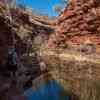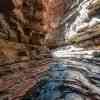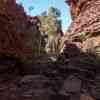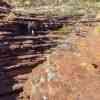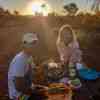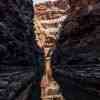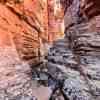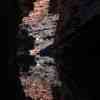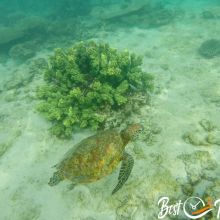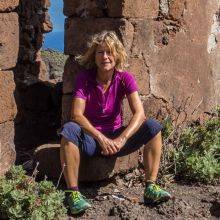When Is the Best Time
Karijini is one of our favourite National Parks in Australia. We have already visited the park twice in different seasons.
The best time to visit Karijini is late autumn, winter, and early spring (May - September), the dry season with the most pleasant temperatures. In April, the gorges' water level may be too high to explore the entire slot canyons. During October, day temperatures can reach 40°C.
The Handrail Pool is reopened in time for the next season. Knox Lookout and Junction Pool Lookout are also accessible again. Unfortunately, the Circular Pool Walk remains closed. However, all other pools are accessible again; Kermits Pool, Weano, Hamersley Gorge, Fortescue Falls, Fern Pool, Joffre Gorge from the Eco Retreat, and Mount Bruce.
My Karijini Guide became much bigger than expected; therefore, I added a Table of Contents for all gorges and hikes below. also, don't miss out on my '9 Must-Know Tips and Facts' at the end of my article.
Weather by Seasons
The weather in Karijini National Park is influenced by the local steppe climate, which is mostly desert climate. It can get boiling, and there are a few months with torrential rain, which might spoil your adventure. Precipitation doesn't occur often, but if it rains, it pours. Check out my detailed monthly guide to find out more:
Spring (September-November)

In September, temps are still bearable, around 30°C. It's a great month to visit the mindblowing National Park, but come before spring break. Swim through the chilly waterholes. You won't believe how cold these waterholes in the gorges are. Increasing day temps in October and November make hiking in Karijini strenuous during the day. Start early in the morning to avoid the midday heat. Carry plenty of water.
Summer (December-February)

Summer isn't got a good season for Karijini. Cyclones, heavy rainfall, and thunderstorms can happen during the rainy season from December to the end of March. Precipitation occurs on average just 32 days a year, but the majority during summer. If it starts raining, you can't enter any of these gorges. Road closures may happen, and you always have to monitor the forecast. Flash floods can occur, and the water is muddy. It is oven-hot, frequently topping 40°C. Even the information centre is closed from mid-December to late February.
Autumn (March-May)
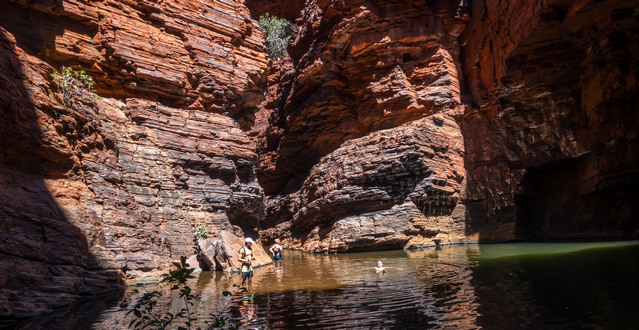
Rain and thunderstorms can occur until the end of March. April is still hot, on average more than 30°C during the day. The gorges might be inaccessible until mid-April if there was too much precipitation before. May and June are great months for Karijini. There are huge waterholes where you have to wade and swim through. The water is freezing. It’s even more fun for the adventurous to climb the different gorges, especially the well-known Weano Gorge. Pleasant day temps range from 22°C to 26°C. Night temps are cool but above 10°C on average.
Winter (June-August)
June is a perfect month to explore Karijini with its waterholes. In the winter months of June and July, days are warm and clear with average daily temps of 22°C while night temps drop below 10°C. The existing waterholes are freezing. Hypothermia can happen, so be careful. It would be best to have a warm sleeping bag for camping; 0°C can occur at night. There is a significant difference in the day and night temperatures during winter. It’s pleasant for hiking because of the low humidity.
Avoiding the Crowds and Busy Times
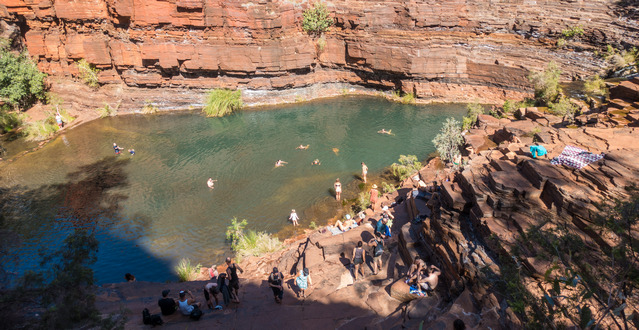
In general, it's not very crowded. However, the season at Karijini starts during the Eastern Holiday and lasts until the end of October. It's busy at Easter, on weekends and during school holidays: Packed adventure tours, hectic campsites, and crowded spots. At this time, the Karijini Eco Retreat, which is ideally located, might be fully booked. Try to avoid Easter, the school holidays in winter (usually, the first two weeks in July), and the spring break at the end of September if possible!: Western Australia School Holidays for the next years.
How Many Days Needed for Karijini
This is one of the frequent questions. I recommend at least three days - four nights to hike and swim in most of the gorges. Getting to Karijini takes an entire day; therefore, don't come in a rush; instead, bring plenty of time for this bucket list destination.
Where to Stay - Karijini Camping (Accommodation Tips)
Top Accommodation Tip: Karijini Eco Retreat: Perfect location, utterly fantastic place. Excellent food and accommodating staff. We came here already twice; once, we spent three nights in a cabin at the end of March, and again, camping for five nights in September. We would book any time again. You can either have dinner in the restaurant or at the burger bar in the evening. They also offer ice for cooling and ice cream, which we appreciated while camping. It's the closest accommodation with luxury tens and a campground for Karijini close to Joffre Falls.

There are 114 campsites plus 12 group campsites available. The bush kitchen and BBQ are average. Solar showers and flush toilets are available but not in high numbers. You may line up if the Savannah campground is fully booked during the holidays.
The Eco tents with quality bedding and private bathrooms were fully booked even at the end of the season in late September. Book your tent in advance if you prefer to stay at the Eco Retreat.

Karijini Eco Retreat; Dorm Cabins with shared bathroom (cheapest option)
Another option is the Dales campground on the eastern side of the park. It's basic bush camping without power or a shower; clean drop toilets are only available. Showers are available at the Information Center. We recommend staying at both campgrounds to enjoy as much of the park as possible. Don't come here in a rush. Karijini is one of the most adventurous and mind-blowing parks in Australia. Stay at least four nights to explore the many gorges.

If you want to visit the entire National Park, staying in Tom Price is pretty convenient. It takes around one hour to get to the different entrances and gorges. There is an excellent bakery offering bread, pies, apple crumble, and coffee. Two liquor stores and a pharmacy are also located in the town centre—all within walking distance. The Tom Price Tourist Park offers a mix of camping, fully equipped cabins, and backpacker rooms.
Packing List for Karijini Camping – Our Experiences

- There is plenty of food, or you can get your meals at the Eco Retreat. To stock up, it’s a one-hour drive to Tom Price. We went to Tom Price for groceries at the beginning and again on the way to Hamersley Gorge.
- Plenty of water plus electrolytes for your strenuous adventures.
- Beverages for the awesome evenings in pitch darkness.
- Sun protection, especially for the face; hat and sunscreen
- Waterproof bag or, even better, a waterproof backpack
- A Fly Head Net is essential after the rainy season. There are still some perky flies at the end of the dry season. We visited the park once in March, and the flies were annoying. Instead, in September, it was okay, just a few were around heads.
- Insect repellent for the campground and the Eco Retreat; there are mozzies at dusk, but not many.
- A headlamp for the night and also for the sunrise hike to the top of Mount Bruce
Best Months to Visit
Karijini offers hikes for all kinds of fitness levels. However, it's quite a journey to come here and the most spectacular gorges Hancock and Weano are for the fit and adventurous only. Knox Gorge is even more challenging, and all other gorges are easier to hike to and through. It's a seven hours drive from Exmouth to Karijini and takes two days from Perth.
Karijini is the second largest National Park in Western Australia, and aboriginal people of different tribes are the owners. It was formerly known as Hamersley Range National Park and got renamed in 1991. Karijini means Hamersley Range by the Banyjima Tribe. The Hamersley region is one of the world's oldest parts, estimated to be at least 3500 million years old.

The information centre offers interesting facts about the history and plenty of hiking trails. It is open from 9 a.m. to 4 p.m. (April to October) and 10 a.m. to 2 p.m. (November to March, but closed from mid-December to mid-February). The information centre is easily accessible on a paved road close to Dales Gorge.

The waterholes were too deep and cold to continue in March.
When we visited Karijini end of March 2015, the water was muddy, and several roads were flooded. We got an impression of what heavy rainfall can cause. There are only gravel roads to the spectacular gorges. I would recommend a 4 WD, although you can get there by a 2WD but there is no guarantee in good conditions. Finally, the road to the Eco Retreat is almost paved except a few hundred meters before.

A 4WD is essential during summer and the beginning of autumn; gorges are often only accessible at this time.
The road at the Eco Retreat itself is gravel; to Dales Gorges, it is paved. Be aware that Tom Price exists for the mineworkers; therefore, accommodation rates are slightly higher. The prices for food in the supermarket are okay. We visited Karijini again in September, years later, this time in the right season. We loved to camp at the Eco Retreat. We were closer to the most adventurous gorges and enjoyed the brilliant night sky, laying on a blanket for stargazing.
Karijini National Park Gorges
When driving to the most spectacular gorges, make a stop at the Oxer Lookout first to get an idea of these impressive gorges.
Hancock Gorge and Kermits Pool

This is a class 5 hike and climb and our favourite gorge. You enter the gorge on a steep ladder. It’s only for experienced hikers with no head for heights. Walk through the gorge until you reach the first pool. From now it is recommended to wade and swim. Walking on the narrow rock ledges may destroy these beautiful stones and cause an injury. You definitely get wet on this gorge trail. The gorge dramatically narrows and gets more spectacular. When you get to the Spider Walk, you have to climb with legs and arms on the rock ledges after the rainy season.
At the end of the dry season, not much water is left and flowing. You can almost walk through it with a little climbing only. The fantastic gorge continues after Kermits Pool but becomes a class 6, which means it’s allowed to do guided only or with a permit from the National Park staff. The best light for perfect shots of this amazing gorge is during midday. Don’t enter the gorge two hours before sunset. Plenty of daylight is necessary for the return hike. Plan 2.5 hours for this 1.5 km trail to enjoy these spectacular sceneries and swim in Kermits Pool. Hancock and Weano Gorge Parking (Google Maps)
Weano Gorge and Handrail Pool

This is the most famous gorge and our second favourite. The Lower Weano Gorge is a class 5 hike and 1 km long. It’s a steep trail down into the gorge. Steep walls are imposing in amazing red colours. From here you need proper shoes with grip to wade through the water. You can hike, swim, and climb until a sign indicates the end. It stops shortly after the Handrail Pool. Swim through the pool and continue to a narrow gorge part on the left.
After this utterly cold and long pool, you reach the end of the trail. It is called Handrail Pool because secured with a handrail to get safe into the pool. Return the same way through the gorge and climb up on the Upper Weano Gorge Trail, which is classified four, but, in my opinion, it was pretty easy to walk. Plan at least 2 hours better 2.1/2 to enjoy the beauty of this adventurous gorge. Weano and Hancock Gorge Parking (Google Maps)
Knox Gorge

When you drive to the Joffre Lookout, continue on this road to get to the most thrilling and challenging gorge in Karijini. The Knox Gorge trail is not for the faint-hearted, but even the view from the lookout is spectacular. It’s a 6 km drive from Joffre Falls on a dirt road. It’s a steep descent that is tricky with loose surfaces and rock climbing. Down at the gorge floor is a refreshing pool to the right after 100 meters. To the left starts this adventurous hike.
The first pool here is pretty long and leads around a corner. Afterwards, the gorge narrows and becomes more of a slot canyon. A stop sign will indicate the end of the self-guided adventure. From here, you can look into the red gorge. If you want to explore the Red Gorge as well, you need to book a guided tour—overall, one of the most exciting gorges ever with plenty of pools. The morning and afternoon sun is much better for perfect canyon shots than at midday. However, in the Slot Canyon, the light is best around noon. Plan enough time for this mesmerizing gorge at least 3 hours better 3.5. Don’t start too late in the day.
Hamersley Gorge

Hamersley Gorge is located northwest of Karijini. You will find two excellent pools here for swimming. It’s quite a drive from both campgrounds, almost 1.5 hours from the Eco Retreat, even longer from Dales, and one hour from Tom Price. The advantage; it’s not busy like Dales Gorge.
It’s a 500 m walk to the first pool a little steep in some sections. From here, turn right, hike and climb to the remote located pool and waterfall. The waterfall is one of the most photographed in Karijini. You may enjoy this pool for yourself. The first pool is relatively easy to access the second is more complicated. It exists second access; instead of walking down to the first pool; have a look to the right. You will see a trail that leads to the second pool. The view from this trail is fantastic, too. Hamersley Gorge Parking (Google Maps Parking)
Dales Gorge

This is the most crowded part of the Karijini National Park due to its easy accessibility. It is lovely here; the pools are great for swimming. The view from the top to the Circular pool is spectacular. Also, this is a permanent pool.
Fortescue Falls and Fern Pool are accessible via a long iron staircase. Fortescue Falls is fantastic for swimming but crowded.
Tip; continue walking to the Fern Falls and Pool. The trail is not marked; therefore, it’s less crowded here. The Fern Pool was our favourite one in Dales, where freshwater runs through it. Hold your feet into the water fishes will nibble at them.

My Tip for Dales Gorge: Hike from the Circular Pool to Fortescue Falls through Dales Gorge. The return hike takes roughly three hours, and is two km long. It’s a class 4 hike, steep in some sections with obstacles in-between. You have to cross from one side to the other of the gorge from time to time. Location Dales Gorge Parking (Google Maps Parking)
Information Centre
Make a stop here to get an idea of the traditional owners and their history. The formation history of the Hamersley Range is explained as well. If camping at Dales, the information centre offers ice for cooling and ice cream, and most important, a shower is available. It is hot in the Karijini during the day. We never ate so much ice cream as we did on our exploration of the Outback. Location Visitor Centre (Google Maps)
Joffre Falls and Gorge
The falls occur after rainfall only. The gorge is located close to the Eco Retreat, a 10 minutes walk. The lookout is spectacular as well but on the opposite of the Retreat. So it makes sense to get to the outlook by car. We experienced the falls after heavy rainfall and the gorge again in the dry season.

It’s a steep class 5 climb down to the river bed and the bottom of the dry waterfall. It’s a strenuous and tricky climb down but well-marked. If you have a day to spare, climb to the bottom of the gorge, it’s not busy here. The red rocks of this spectacular gorge look fantastic in the sunlight. The heat is bearable in the morning and late afternoon. The pool is excellent for swimming after the rainy season. The water doesn't look so clean at the end of the dry season.
Mount Bruce
It is a beautiful hike to watch the sunrise with spectacular scenery from the top. The trail is 10 km long and takes about 2.5 hours one way. Bring a torch and breakfast for the early morning hike. It gets pretty hot during the day. Very view people hike to the top of Mount Bruce. It’s half an hour drive from the Eco Retreat to the car park of the trailhead. Hat, sunscreen, and plenty of water are essential.
9 Must-Know Tips and Facts

- Most areas of the southern half of the park are inaccessible. Visitors focus on the stunning gorges in the northern part, with their rock pools, waterfalls, and unique wildlife to view.
- Explore! Deep canyons wind endlessly through red rock walls. Find hidden waterfalls with their own private swimming pools, tall gorges, ancient trees, etc. Consider booking a local tour if you are an inexperienced hiker. Each canyon has its own difficulty level. Level 5 in the Joffre Gorge or the Handrail Pool at the lower Weano Gorge are for more experienced hikers.
- We often get asked if there are crocodiles in the waterholes. Karijini is different from Kakadu at the Top End. The sea is too far away for the salties. Also, freshwater crocodiles don't occur here. There are no billabongs (ponds).
- Be prepared with a fly net for the face shortly after the rainy season during the day when thousands of annoying flies are trying to get into your eyes or nose.
- Stay back from dangerous cliff edges with loose rocks near the rim. They are often about 100 meters high.
- Flash floods can occur and are extremely dangerous. Do not enter gorges if there is rain. If it starts raining while you are in a ravine, leave immediately.
- The water in gorge pools can be icy. Be careful, especially when they are deeper from March to May. However, even in September, the water is pretty cold. Avoid diving or staying in the water for extended periods, as hypothermia can occur.
- During summer, it can get boiling: Above 40°C. Bring plenty of water if you visit in summer.
- Dingos are common around the Dales campground. They may scavenge for food and can become aggressive at times. Don't leave leftovers around your tent. Do not feed them, supervise children, and walk-in groups.

Top Events in Karijini and Tom Price
- Utterly unique is the Karijini Experience held each year in the April school holidays. It is held by the Banjima people in partnership with local agencies and organizations. Offered are Yoga classes in one of the gorges, meditation, live music, fine dining, bush culture walk, storytime, bush medicine, and much more. You like to learn more or be part of it? Book your accommodation and ticket soon!
- The Mount Nameless Jarndunmunha Festival is held in August. Tom Price is home to this festival for 50 years already — featuring live music, a street parade, different food stalls, fireworks, and more.
Please get in touch with me if you wish to use any of my photos, but I will take action against picture theft.



























